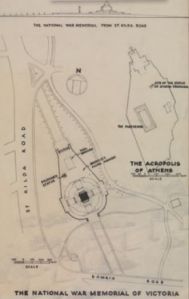EE Milston: Personal Records & Records of His Architecture Practice

Part of proposal submitted by EE Milston
Ink and pencil on tracing paper
EE Milston 1976.0025
Victoria’s monument to those who served in the second world war was designed by a man whose personal experience of that war brought him to Australia. Born in Czechoslovakia in 1893, Arnost Edward Mühlstein established his architectural practice in the modernist style and travelled widely in Europe to study architecture of all periods. Mühlstein was Jewish – warned of his impending arrest, he fled Czechoslovakia in 1939.
Arriving in Adelaide in 1940, Mühlstein joined the practice of Lawson & Cheesman and began to settle in to a new city, taking an active role in local theatre. He enlisted as a ‘friendly alien’ with the Royal Australian Engineers, which brought him to Melbourne in 1945. At the end of the war he remained in Victoria, acquired Australian citizenship and anglicised his name to Ernest Edward Milston.
Following WWII, the Trustees of the Shrine of Remembrance sought concepts for a memorial to complement the WWI Shrine of Remembrance. Two architects proposed a forecourt with EE Milston’s design selected. Records held in the Milston collection at UMA reveal that his design had classical roots, to continue the concepts already embodied in the WWI Shrine (the Mausoleum of Halicarnassos and the Forecourt based on the Acropolis in Athens). Milston’s design features flagpoles to represent the armed forces, an eternal flame and a cenotaph with sculpture created by George Allen. Her Majesty, Queen Elizabeth II dedicated the Forecourt during her first visit to Australia.
In the 1950s, Milston designed many commercial properties and private residences, his clients included mining executive, AJ Keast, historian Geoffrey Blainey and artist Louis Kahan. For CRA, Milston and partner Don Fulton, designed the Queensland town of Mary Kathleen following the discovery of uranium in the area in 1954. Following the closure of the mine in 1982, everything in the town was auctioned and Mary Kathleen became a ghost town, remembered by those who lived there, a handful of buildings moved to new sites, and the records held at UMA.
The site plan shown here was exhibited in the exhibition, Wealth of Details in 2012, associated with Open House Melbourne (OHM). In 2014, OHM will run over the weekend 27 and 28 July.
The National War Memorial of Victoria, Part of proposal submitted by EE Milston, Ink and pencil on tracing paper, EE Milston 1976.0025
Contributor: Sophie Garrett, University of Melbourne Archives
Leave a Reply